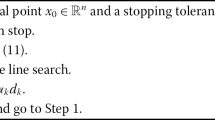Abstract
We present an algorithm for minimax optimization that combines LP methods and quasi-Newton methods. The quasi-Newton algorithm is used only if an irregular solution is detected, in which case second-order derivative information is needed in order to obtain a fast final rate of convergence. We prove that the algorithm can converge only to a stationary point and that normally the final rate of convergence will be either quadratic or superlinear. The performance is illustrated through some numerical examples.
Similar content being viewed by others
References
J.W. Bandler and C. Charalambous, “New algorithms for network optimization”,IEEE Transactions on Microwave Theory Technique MTT-21 (1973) 815–818.
C.G. Broyden, “A class of methods for solving nonlinear simultaneous equations”,Mathematics of Computation 19 (1965) 577–593.
C.G. Broyden, J.E. Dennis and J.J. Moré, “On the local and superlinear convergence of quasi-Newton methods”,Mathematics of Computation 12 (1973) 223–246.
C. Charalambous and A.R. Conn, “Optimization of microwave networks”,IEEE Transactions on Microwave Technique MTT-23 (1975) 834–838.
C. Charalambous and A.R. Conn, “An efficient method to solve the minimax problem directly”,SIAM Journal on Numerical Analysis 15 (1978) 162–187.
C. Charalambous and O. Moharram, “A new approach to minimax optimization”, Department of Systems Design, University of Waterloo, Waterloo, Ont. (1978) 1–4.
F.H. Clarke, “Generalized gradients and applications”,Transactions of the American Mathematical Society 205 (1975) 247–262.
A.R. Conn, “An efficient second order method to solve the (constrained) minimax problem”, Department of Combinatorics and Optimization, University of Waterloo, Waterloo, Ont., Report CORR 79-5 (1979) 1–48.
W.C. Davidon, “Optimally conditional optimization algorithms without line searches”,Mathematical Programming 9 (1975) 1–30.
V.F. Dem'yanov and V.N. Malozemov,Introduction to minimax (Wiley, New York, 1974). Translated from:Vvedenie v minimaks (Izdatel'stvo “Nauka”, Moscow, 1972).
J.E. Dennis and J.J. Moré, “Quasi-Newton methods, motivation and theory”,SIAM Review 19 (1977) 46–89.
J. Hald and K. Madsen, “A 2-stage algorithm for minimax optimization”, in:International symposium on systems optimization and analysis, Lecture notes in control and information sciences 14 (Springer, Heidelberg, 1978) 225–239.
S.P. Han, “Superlinear convergence of a minimax method”, Report TR 78-336, Department of Computer Science, Cornell University, Ithaca, NY (1978) 1–21.
R. Hettich, “A Newton-method for nonlinear Chebyshev approximation”, in: R. Schaback and K. Scherer, eds., Approximation theory, Lecture Notes in Mathematics, 556 (Springer, Berlin, 1976) 222–236.
K. Madsen, “An algorithm for minimax solution of overdetermines systems of non-linear equations”,Journal of the Institute of Mathematics and its Applications 16 (1975) 321–328.
K. Madsen and H. Schjaer-Jacobsen, “Singularities in minimax optimization of networks”,IEEE Transactions on Circuits and Systems (1976) 456–460.
K. Madsen and H. Schjaer-Jacobsen, “Linearly constrained minimax optimization”,Mathematical Programming 14 (1978) 208–223.
M.J.D. Powell, “A new algorithm for unconstrained optimization”, in: J.B. Rosen, O.L. Mangasarian and K. Ritter, Eds.,Nonlinear programming (Academic Press, New York, 1970).
J.B. Rosen and S. Suzuki, “Construction of non-linear programming test problems”,Communication of the Association for Computing Machinery 8 (1965) 113.
H.H. Rosenbrock, “An automatic method for finding the greatest or least value of a function”,The Computer Journal 3 (1960) 175–184.
G.A. Watson, “The minimax solution of an overdetermined system of non-linear equations”,Journal of the Institute of Mathematics and its Applications 23 (1979) 167–180.
Author information
Authors and Affiliations
Rights and permissions
About this article
Cite this article
Hald, J., Madsen, K. Combined lp and quasi-Newton methods for minimax optimization. Mathematical Programming 20, 49–62 (1981). https://doi.org/10.1007/BF01589332
Received:
Revised:
Issue Date:
DOI: https://doi.org/10.1007/BF01589332




